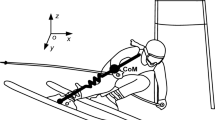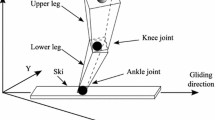Abstract
This paper presents a new study on modeling and optimization of trajectory and posture for the super-giant (SG) slalom of alpine skiing. It is the first time that a Three-Rigid-Body-Particle model based on rigorous derivations and stability analysis is established to represent skiers trajectory and posture characteristics, as it is more accurate than the single-rigid-body model which is commonly used in existing studies. In addition, the Radau pseudospectral method is applied to solve the trajectory and posture optimization problem in order to obtain better skiing trajectory, skiing posture, and some key kinematic parameters of skiers. Moreover, this paper analyzes the effects of different body types, minimum turning radii, and flexor and extensor strength of knees and hip joint on skiing performance. Finally, based on the findings of the study, some advice about how to improve the performance of the SG slalom in view of science and technology is given to skiers and coaches for reference.
Similar content being viewed by others
References
Natalia B, Carlota T, Robert H, et al., Overview of complex systems in sport, Journal of Systems Science & Complexity, 2013, 26(1): 4–13.
Julian M J, Mora A M, and Carlos C, Complex systems in sports: Introduction to the special issue, Journal of Systems Science & Complexity, 2013, 26(1): 1–3.
Sung D J, Park S J, Kim S, et al., Effects of core and non-dominant arm strength training on drive distance in elite golfers, Journal of Sport and Health Science, 2016, 5(2): 219–225.
Malte S and Martin L, Modeling soccer by means of relative phase, Journal of Systems Science & Complexity, 2013, 26(1): 14–20.
Allinger T L and Bogert A, Skating technique for the straights, based on the optimization of a simulation model, Med. Sci. Sports Exerc., 1997, 29(2): 279–286.
Cai C and Yao X, Trajectory optimization with constraints for alpine skiers based on multi-phase nonlinear optimal control, Frontiers of Information Technology & Electronic Engineering, 2020, 521(10): 1521–1534.
Legotin S D, Obnosov K B, and Rivlin A A, Mechanics of alpine skiing: Carve turn with angulation, Journal of Physics: Conference Series, 2020, 1705(1): 12034–12046.
Komissarov S S, Dynamics of carving runs in alpine skiing, The basic centrifugal pendulum, Sports Biomechanics, 2022, 21(8): 890–911.
Cai C and Yao X, Dynamic analysis and trajectory optimization for the nonlinear ski-skier system, Control Engineering Practice, 2021, 114(1): 104868.
Morawski J M, Control systems approach to a ski-turn analysis, Journal of Biomechanics, 1973, 6(3): 267–279.
Rudakov R, Lisovski, Ilyalov O, et al., Optimisation of the skiers trajectory in special slalom, Procedia Engineering, 2020, 2(2): 3179–3182.
Sundstrm D, Carlsson P, Sthl F, et al., Numerical optimization of pacing strategy in cross-country skiing, Structural and Multidisciplinary Optimization, 2013, 47(6): 943–950.
Sun Y, Guo R, Gao L, et al., Research on the inrun profile optimization of ski jumping based on dynamics, Structural and Multidisciplinary Optimization, 2021, 63(3): 1481–1490.
Hubisz J L, The physics of skiing: Skiing at the triple point, The Physics Teacher, 2004, 42(5): 318–318.
Erbatur K, Okazaki A, Obiya K, et al., A study on the zero moment point measurement for biped walking robots, 7th International Workshop on Advanced Motion Control, Maribor, 2002, 431–436.
Ma B, A singular linear quadratic time-iInconsistent optimal control problem, Journal of Systems Science & Complexity, 2023, 36(3): 1024–1052.
Liu J, Wang Y, and Zhang N, Optimal reinsurance and dividend under model uncertainty, Journal of Systems Science & Complexity, 2023, 36(3): 1116–1143.
Wang D, Pan Q, Hu J, et al., Nonlinear model predictive control for trajectory tracking of quadrotors using Lyapunov techniques, Science China Information Sciences, 2022, 65: 1–2.
Li J, Fuel-optimal low-thrust formation reconfiguration via Radau pseudospectral method, Advances in Space Research, 2016, 58(1): 1–16.
Ross I M and Karpenko M, A review of pseudospectral optimal control: From theory to flight, Annual Reviews in Control, 2012, 36(2): 182–197.
Garg D, Patterson M, Hager W W, et al., A unified framework for the numerical solution of optimal control problems using pseudospectral methods, Automatica, 2020, 46(11): 1843–1851.
Garg D, Hager W W, and Rao A V, Pseudospectral methods for solving infinite-horizon optimal control problems, Automatica, 2011, 47(4): 829–837.
Huntington G T and Rao A V, Optimal reconfiguration of spacecraft formations using the Gauss pseudospectral method, Journal of Guidance Control & Dynamics, 2012, 31(3): 689–698.
Han F, Wang Z, He L, et al., Trajectory plan for an ultra-short distance on-orbit service based on the Gaussian pseudo-spectral method, IEEE/CAA Journal of Automatica Sinica, 2018, 1–9, DOI: https://doi.org/10.1109/JAS2017.7510892.
Jorris T R and Cobb R G, Three-dimensional trajectory optimization satisfying waypoint and no-fly zone constraints, Journal of Guidance, Control, and Dynamics, 2009, 32(2): 551–572.
Wu B, Qian L, Lu M, et al. Optimal control problem of multi-vehicle cooperative autonomous parking trajectory planning in a connected vehicle environment, IET Intelligent Transport Systems, 2020, 13(1): 1677–1685.
Wang D, Wang Z, Wu Z, et al., Distributed convex optimization for nonlinear multi-agent systems disturbed by a second-order stationary process over a digraph, Science China Information Sciences, 2022, 65(3): 132201.
Zhou Z, Liu Z, Su H, et al., Multi-objective optimization for 10-kW rated power dynamic wireless charging systems of electric vehicles, Science China Information Sciences, 2022, 65(10): 202201.
Delp S L, Loan J P, Hoy M J, et al., An interactive graphics-based model of the lower extremity to study orthopaedic surgical procedures, IEEE Transactions on Biomedical Engineering, 1990, 37(8): 757–767.
Author information
Authors and Affiliations
Corresponding author
Ethics declarations
SUN Jian is an editorial board member and ZHANG Yanjun is a youth editorial board for Journal of System Science & Complexity and was not involved in the editorial review or the decision to publish this article. All authors declare that there are no competing interests.
Additional information
This research was supported in part by the Key Technology Research and Demonstration of National Scientific Training Base Construction of China under Grant No. 2018YFF0300800, in part by the National Natural Science Foundation of China under Grant No. 62173323, and in part by Beijing Institute of Technology Research Fund Program for Young Scholars.
Rights and permissions
About this article
Cite this article
Zhang, Y., Fei, Q., Yao, X. et al. Three-Rigid-Body-Particle Modeling and Optimization of Trajectory and Posture for Alpine Skiing. J Syst Sci Complex 37, 581–608 (2024). https://doi.org/10.1007/s11424-024-3021-7
Received:
Revised:
Published:
Issue Date:
DOI: https://doi.org/10.1007/s11424-024-3021-7




